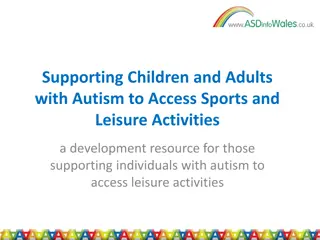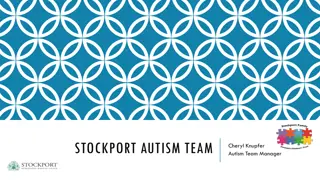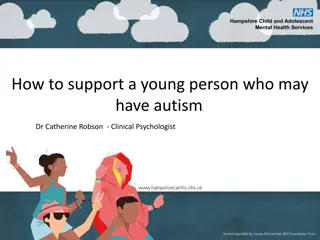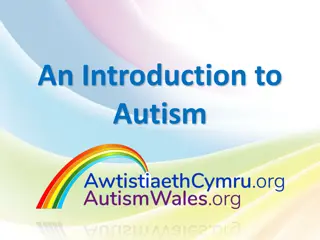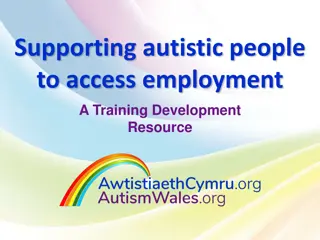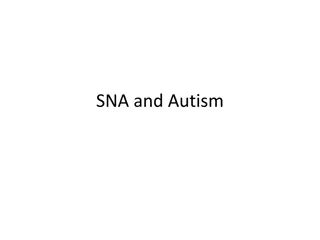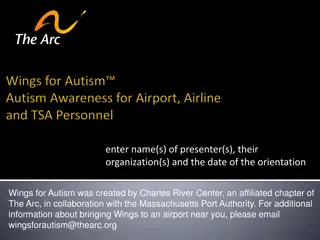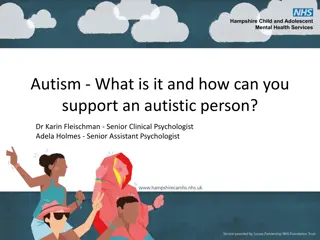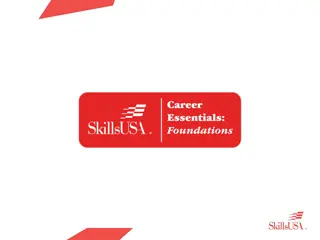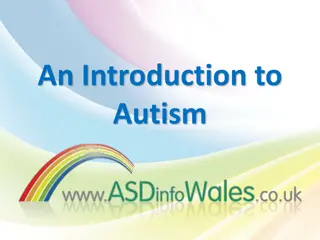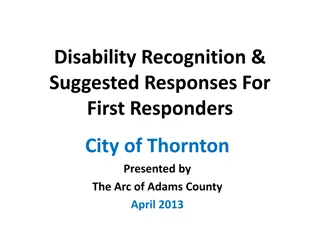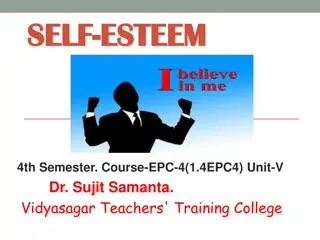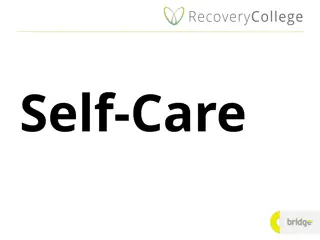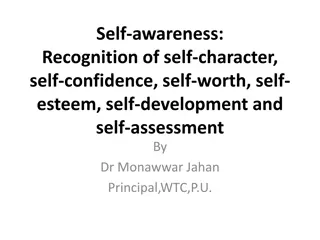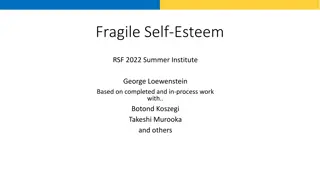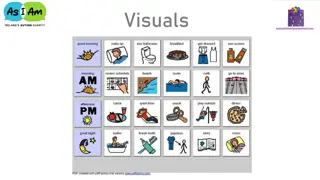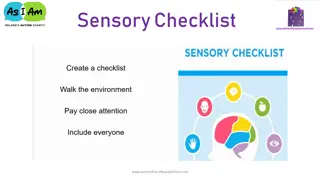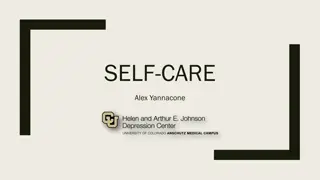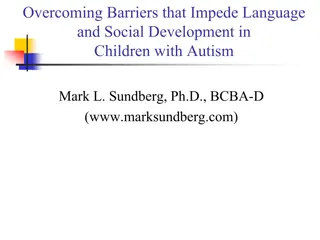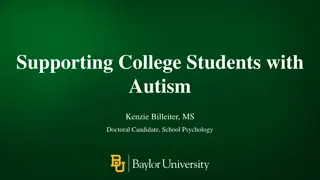Teaching Self-Help Skills to Individuals with Autism
Focusing on teaching self-help skills to individuals with autism is crucial for fostering independence and integration into the community. Parents play a key role in this process, although it can be complex and time-consuming. The Individuals with Disabilities Education Improvement Act of 2006 highlights the importance of addressing all areas of development, including self-help skills, in schools. Overcoming the challenges and weaknesses faced by individuals with ASD requires a targeted approach that emphasizes motivation, effective tools for change, and understanding unique cognitive and sensory sensitivities.
Download Presentation

Please find below an Image/Link to download the presentation.
The content on the website is provided AS IS for your information and personal use only. It may not be sold, licensed, or shared on other websites without obtaining consent from the author. Download presentation by click this link. If you encounter any issues during the download, it is possible that the publisher has removed the file from their server.
E N D
Presentation Transcript
Striving for Independence: Teaching Self-Help Skills to People with Autism Jennifer A. Toomey The Summit Center Getzville, NY
Agenda Why teach self-help skills Choosing the right skills Motivating your child to learn Using effective tools for change
Emphasizing the Development of Self-Help Skills Focus too little on self-help development particularly with young children Easier to simply do it for the child An area where parents may feel successful fostering dependency Adaptive deficits > Cognitive deficits 4
Why is it important Adaptive skills signal the beginning of independence from parents Failure to address may prevent community integration, school functions, recreational activities, and eventually housing and job opportunities Challenging behavior and the absence of S-H skills most often associated with out-of-home placement 5
Weaknesses for children with ASD Problem with generalization Problem learning complex skills requiring abstraction or attention to social norms Ability to understand language Restricted/stereotyped range of interests- attention Sensory sensitivities Other behavioral concerns
Parents Role Teaching self-help skills is complex Significant investment of time May be able to scaffold on top of things already doing Are there limits on what parents can be expected to accomplish?
Schools Role Individuals with Disabilities Education Improvement Act Revised, 2006 Indicates a responsibility to address all areas of development, including self-help
Schools Role General education focus on meeting academic standards Most kids come prepared already Environment not very conducive to instruction (e.g., toileting skills) Focus on transfer of skills Measuring success at school (check lists) Special education greater responsibility
Is the child ready? Age-Appropriate (don t get too far ahead)? Functional Skills (important for child now)? Prerequisite behaviors (able to attend and follow simple instructions; imitation)? Shown any interest? Any physical limitations (accommodations)?
Learning-to-Learn Skills Consistently looks when you call his name? Pays attention when given a direction? Follows simple one-step directions such as come here, sit down, wait, stand up, give me ? Consistently makes and sustains eye-contact for at least three seconds? When asked to, looks at objects or materials? Sits or remains in a defined area for at least 10 minutes (with or without close supervision)?
Learning-to-Learn Skills (continued) Communicates simple wants and needs? Points to common body parts? Responds to physical guidance without resistance? Imitates simple motor actions?
Skills Inventory Functional Area Tasks Skill Targets Prioritize Develop goals
Need for Rewards Items that many of us find reinforcing (e.g., recognition, task completion, etc.) may not be sufficient to motivate children with autism
Potential Reinforcers Praise most practical Food very powerful Attention (verbal and physical) Activities Praise + Super rewards
Examples of Activity Reinforcers Spending time with preferred people Special activities Recess, computer time Special responsibilities Line leader, picking story
Fading Reinforcers Frequent use of rewards is a tool for teaching, not the end result Gradually begin to expect more from the child before reinforcement is delivered Fading too quickly may lead to failure, while waiting too long may lead to increased dependence Fade to a level that is to be expected in the most natural setting
USING EFFECTIVE TOOLS FOR CHANGE
Steps to Successful Teaching 1. Clearly specify the target skill 2. Break complex skills into smaller steps 3. Use a systematic approach to teaching 4. Monitor progress 5. Modify the approach, as needed, based on the progress achieved
Step 1: Specifying the goal Four basic components: 1. An instructional context in which the skill will occur 2. Pinpoint observable and measurable behaviors 3. Should be realistically attainable within a few months 4. Should specify the mastery criteria (how and when you will know the student has acquired the skill)
Examples With her shirt over her head [context], Anna will finish putting on her shirt [behavior]. With her shirt laid on her bed, Anna will put her shirt on. After hearing and responding to an alarm clock, Anna will dress herself.
Step 2: Breaking tasks into steps A Task Analysis breaks a task into smaller, more easily attainable steps The number of steps depends on the student s prerequisite abilities and skills Increases the number of opportunities for reinforcement and success
Handwashing Task Analysis 1. 2. 3. 4. 5. 6. 7. 8. 9. 10. Takes towel 11. Dries hands Turn on warm and cold water Places hands under water Places one hand under and other hand under soap dispenser Pushes soap down Rubs soap between hands Rubs back of right hand Rubs back of left hand Rinses hands under water Turns off water
Step 3: Systematic approaches to teaching Frequently practice emerging skills Provide high levels of repetition Commit to a teaching approach until its results can be clearly evaluated Utilize proven tools for instruction, including: Chaining Prompting Shaping
Chaining A method of linking relatively simple steps (task analysis) to form a more complex task (a chain of behavior) Each step in the chain signals the next step to be completed and reinforces the previous step Three methods of chaining: Backward, Whole chain, Forward
Chaining Method Establish a baseline of how the child completes the task without any assistance If child can complete some steps and needs little physical assistance, use whole-chain If child cannot complete most steps but can respond to delayed reinforcement, use forward If child cannot complete most steps, needs physical assistance and/or needs immediate feedback, use backward
Using Chaining with Toothbrushing Step Independent 1. Pick up toothpaste Yes 2. Remove cap and hold tube with one hand Yes 3. Pick up toothbrush with other hand Yes 4. Place a small amount of paste on brush Yes 5. Turn on cold water Yes 6. Wet toothbrush Yes 7. Place toothbrush against teeth No 8. Move toothbrush up and down 10 times No 9. Spit toothpaste into sink Yes 10. Rinse mouth with water Yes 11. Place toothbrush into holder Yes
Prompting Essential to teach a skill not in the student s repertoire Must be faded quickly and systematically Avoid prompt dependence Most-to-least method of fading
Types of prompts Type of Prompt Example Physical guidance Hand-over-hand: Place your hand over child s hand, pick up toothbrush and bring up to the child s mouth Partial guidance: Tap the child s arm to assist him in picking the toothbrush up to his mouth Visual cue Show a picture of a child brushing his/her teeth Modeling Get the child s attention and show them how to brush their teeth Gestural Point to the toothbrush Verbal Say Pickup your toothbrush
Shaping Using reinforcement with approximations of a newly developed or rarely occurring behavior
Step 4: Monitoring progress Need to consistently monitor student s progress and compare to the learning goals that have been established Rate of progress will vary by child and will be influenced by the complexity of the skill being taught, the consistency of the teaching methods and other factors (e.g., location, number of opportunities, etc)
Examples of Objective Measurement Measure Explanation Example How often the child initiates going to the bathroom John will have no more than one toilet accident a week. Frequency Each sequenced step is scored as correct or incorrect. Erin will shave, completing 80% of the steps with no help. Number of successfully completed steps The parent counts the number of times that they have to help (prompt). James will tie his shoes with two or fewer prompts. Number of prompts The parent measures how long it takes the child to complete the task. Useful when the child is slow to complete them. Keri will eat his lunch and clear his plate and utensils within 20 minutes. Duration Record whether the child dressed in clothing that was color coordinated. Ricky will dress himself in a shirt and pants that are color coordinated. Accuracy Combining two or more dimensions into a single criterion. Terri will brush her hair and teeth within 15 minutes with two or fewer prompts. Combined method
Step 5: Modifying teaching Monitoring progress is not very beneficial unless the data collected is useful in making decisions to enhance teaching Frequently, simple instructional modifications can be made if the student is not meeting their goals in the desired time frame Will discuss options later
Writing an instructional plan A detailed plan facilitates organized and systematic instruction Allows multiple people to instruct the student in a similar manner
Summary Teaching self-help skills to children with autism may be one of the most important things a parent, teacher or caregiver does Independence from caregivers opens the door to many opportunities Starting too late, may require undoing bad habits before new skills can be added
Questions?? jtoomey@thesummitcenter.org Thank you!


